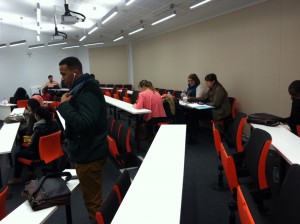Looking for creative teaching activities? Encourage students to work collaboratively and motivate each other’s learning, to clarify their understanding of course content and reflect on different peer perspectives. Take a look at the group work suggestions in our series of blog posts. We recommend booking City’s new Learning Spaces to run these activities.
Why?
In Learning Cell, students individually develop questions and answers and alternate between answering and asking them. The activity leads students to actively think about taught content, generate thought-provoking questions and check their understanding. It also reaps the benefits of pair work: discussion, receiving and giving feedback, admitting confusion and asking for help.
Learning Cell, which works well with small groups of students, can be applied in different disciplines and the training of students to create thought-provoking questions has been suggested to enhance learning (Svinicki, et al., 2010).
Technique
- Ask students to individually write questions and answers dealing with the major points raised in a reading or other learning assignment.
Students can also access the information (read, watch a video, etc.) before the lecture. The complexity of the questions and answers students are asked to write depends on the amount of time you have: if research is needed, students can write their questions and answers outside the lecture. However, the Q&A by students and the following facilitation by you benefit from face to face presence.
- Prepare your students to write good questions.
The questions types should be varied (open answers, multiple choice, etc.) depending on the time given for the activity and should aim to cover different levels of learning (recalling knowledge, application, analysis, etc.) and have different purposes (challenge, summarise, criticise, etc.). For some guidance on writing multiple choice questions, go here and for ideas on writing open answers, click here.
- Get students into pairs.
If you’re using rooms with node chairs or chairs with castors (see below), ask students to face each other by rearranging the chairs; leave space to move around, help students and give feedback. If you’re using BLG07, the swivel chair lecture theatre, ask students to pair up with the person next to them.
- Explain how each student will alternate between asking and answering each other’s questions.
Example
|
Favourite room for this activity
- Rooms with tables and chairs with castors and squiggle glass: A109, A214, AG08, B307B/C, BLG08, BM02, BM03, C340, D104 and E212
- Collaborative style lecture theatre seating with squiggle glass- BLG07 has fixed swivel seating
- Learning rooms with Node chairs and squiggle glass: A112 and D222. AG24B (SHS only).
References
This blog draws on the following works:
Barkley, E.F., Cross, K.P., and Major, C.H. 2005. Collaborative Learning Techniques: A Handbook for College Faculty. San Francisco: Jossey-Bass.
Svinicki, M. et al. 2010. McKeachie’s Teaching Tips: Strategies, Research, and Theory for College and University Teachers. 13th Edition. CENGAGE Learning Custom Publishing. Belmont.




Leave a Reply